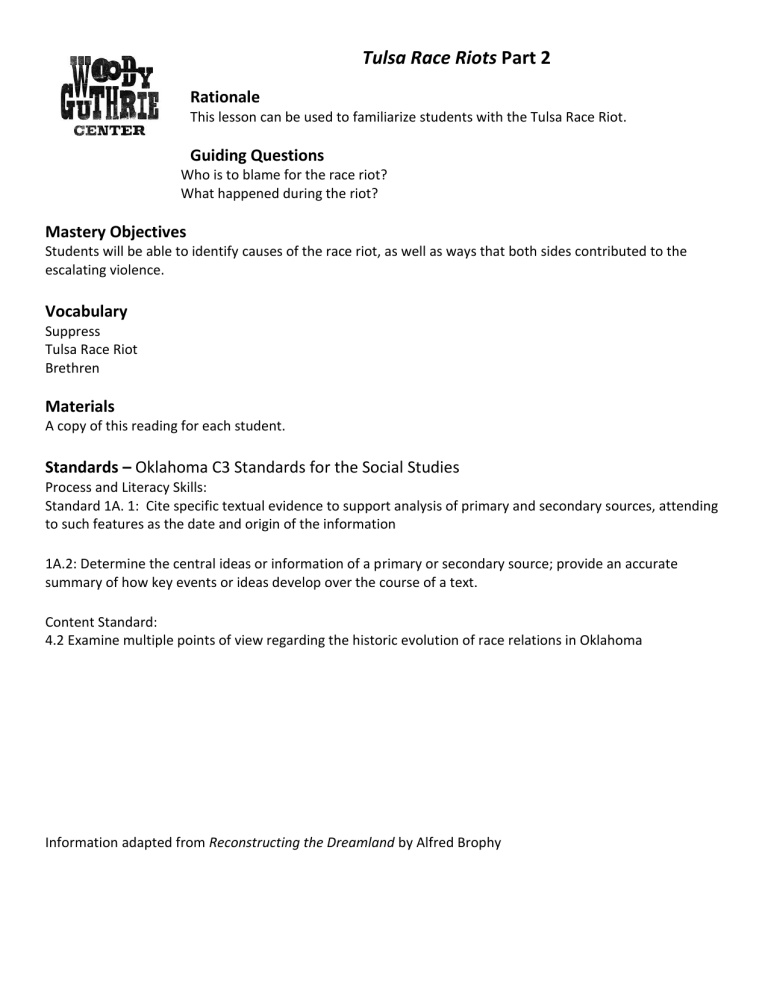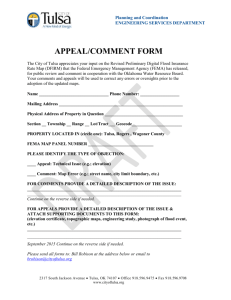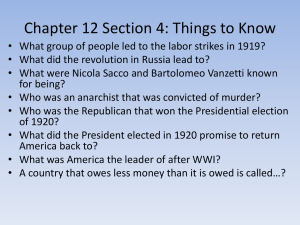
Tulsa Race Riots Part 2 Rationale This lesson can be used to familiarize students with the Tulsa Race Riot. Guiding Questions Who is to blame for the race riot? What happened during the riot? Mastery Objectives Students will be able to identify causes of the race riot, as well as ways that both sides contributed to the escalating violence. Vocabulary Suppress Tulsa Race Riot Brethren Materials A copy of this reading for each student. Standards – Oklahoma C3 Standards for the Social Studies Process and Literacy Skills: Standard 1A. 1: Cite specific textual evidence to support analysis of primary and secondary sources, attending to such features as the date and origin of the information 1A.2: Determine the central ideas or information of a primary or secondary source; provide an accurate summary of how key events or ideas develop over the course of a text. Content Standard: 4.2 Examine multiple points of view regarding the historic evolution of race relations in Oklahoma Information adapted from Reconstructing the Dreamland by Alfred Brophy Memorial Day 1921 started innocently enough for Dick Rowland, a black man who worked in Tulsa on the ground floor of the Drexel Building shining shoes. He had taken the elevator to the bathrooms on the top floor. Upon returning to the ground floor, the white elevator attendant, Sarah Page, began to scream. According to Page, Rowland assaulted her in the elevator. At a time when relations between Blacks and Whites were already tense, this allegation was sure to spark outrage. Rowland was arrested soon after, and Greenwood residents began to fear the possibility of lynching. That evening, several hundred people gathered at the courthouse; some were there to take Rowland from his cell, and others were there to protect him. Sheriff W.M. McCullough had locked Rowland on the top floor of the courthouse. He had instructed his jailers to lock the doors and not open them no matter what. Meanwhile in Greenwood, men were meeting at the Tulsa Star newspaper offices. A.J. Smitherman, the paper’s editor, had previously written in his paper his philosophy on lynching and what should be done to prevent it, which was to, “…take life if need be to uphold the law and protect the prisoner.” Tulsa Daily World June 1, 1921 The following poems were written by A.J. Smitherman. Smitherman was a black lawyer and newspaper editor who advocated for the black community to arm itself to protect its brethren from lynching. Whence those sounds in all directions Firearms cracking everywhere; Men and women all excited, Cries of rioting fill the air. Men with guns acid ammunition, Rushing ‘madly to the fray, Shooting, cursing, laughing, crying, “Come on, boys, come on this way!” “They are trying to lynch our comrade, Without cause in law defy; Get your guns and help defend him; Let’s protect him, win or die.” ‘Twas the cry of Negro manhood, Rallying to the cause of right, Ready to suppress the lawless, Anxious for a chance to fight. What is the mood of the black rioters? What words or phrases support your choice? Why might they feel this way? Why did blacks feel their cause was “right”? So they marched against the mobbists, Gathered now about the jail, While the sheriff stood there pleading, Law and order to prevail. A.J. Smitherman, Reconstructing the Dreamland(28) Groups of black men crossed the tracks from Greenwood into downtown Tulsa. At the courthouse, they met equally aggressive Whites. There, at least one man began trying to disarm the black men; a struggle ensued, a shot was fired. According to Sheriff W.M. McCullough, “every negro drew his gun and started shooting.” In the chaos that followed, Whites tried to get guns anywhere they could. Local pawn shops and hardware stores were cleared of weapons and ammunition; some were opened voluntarily while others were broken into. Soon, an army of several hundred men were being drilled and coached. Quick they fled in all directions, Panic stricken, filled with fear, Leaving their intended victim As the news spread far and near. Scattered now in great confusion, Filled with vengeance all anew, Leaders of the lynching party Planned for something else to do. “Blacks Prevent a Negro’s Lynching” Read a bold newspaper head, In an extra night edition, “Fifty Whites Reported Dead.” Rallied now with reinforcements, Brave (?) white men five thousand strong Marched upon the black defenders With their usual battle song: “Get the niggers” was the slogan Kill them, burn them, set the pace, Let them know that we are white men, Teach them how to keep their place. A.J. Smitherman Reconstructing the Dreamland (34) As skirmishes and gunfire broke out in Greenwood, or “Little Africa” as it was sometimes called, businesses and houses were also being torched. The white mob prevented the Fire Department from putting the fires out. The blacks, too, were well-armed with guns, sticks, and bricks. The chaos was everywhere; many families were piling into their cars and leaving town. Tulsa Daily World June 19, 1921 In response to the “negro uprising,” the Tulsa Police Department commissioned approximately 250 men as deputies; these men were deputized without sufficient training or screening. Weapons were being handed out indiscriminately to whites; they could not even keep track of to whom they had issued weapons. City officials ordered anyone not deputized to be disarmed. Cars were arriving in downtown filled with armed men. Rumors that blacks had called in help from neighboring Muskogee caused TPD to post a machine gun crew on the road. No such help ever arrived. The Tulsabased National Guard units also arrived. Greenwood residents geared up for a fight. Many tried to hold off whites at the tracks – the unofficial border between white and black Tulsa – while others bunkered down much like they had done while fighting in the war. Despite their efforts, the fighting had spread across Greenwood within a few hours. Most of the resulting destruction was done by white police officers, deputies, mobs, and local National Guard units. In an effort to protect the Greenwood residents, the National Guard units disarmed and arrested them, leaving their property unguarded and susceptible to looting and burning. The all out invasion of Greenwood began at the sound of the 5 a.m. whistle on June 1, 1921. Black residents being frisked for weapons National Guard patrolling Greenwood Images from: Beryl Ford Collection / Rotary Club of Tulsa / Tulsa County Library / Tulsa Historical Society www.tulsagal.net August 19, 2013 Several witnesses reported white police officers and recently deputized men killing blacks in cold blood. Oklahoma City-based units of the National Guard began to arrive in Tulsa, but rather than heading to Greenwood, they reported to the police station. The shooting reportedly ceased around 11:00 a.m. due to the fact that nearly all Greenwood residents had been driven out of town or detained. According to Adjutant General Charles F. Barrett, the special deputies were, “the most dangerous part of the mob” (59). The official count for lost lives in the riot is 24 blacks and 10 whites; officials now admit that those numbers are low, but no other count can be agreed upon. In the immediate aftermath of the riot, the focus was on the cleanup, not counting the number of dead or wounded. Those that survived the riot faced additional hardship: the destruction of their property. Thirty-five blocks were burned leaving over 1,000 people homeless. Note the planes in the skies of each picture. Many people claim that planes were used by whites during the race riot to surveil the movements of blacks and drop bombs on Greenwood. There is little evidence to support this. What comparisons and contrasts are made between whites in Tulsa and Germans in WWI? What is the artist’s message in these images? Reconstructing the Dreamland (49) Tulsa with her teeming millions Paid the toll for racial strife, But her black men won a victory With their blood they paid the price. Nobly they had stopped a lynching, Taught a lesson for all time, Saved a man the Court has since found Innocent of any crime. What victory did they win? What “lesson” was taught? Though they fought the sacrificial Fight with banners flying high, Yet the thing of more importance Is the way they fought--and why! What is important about the way they fought? A.J. Smitherman Reconstructing the Dreamland (61) The Dallas Express October 15, 1921 Beryl Ford Collection / Rotary Club of Tulsa / Tulsa County Library / Tulsa Historical Society www.tulsagal.net August 19, 2013 The following is from an article written by A.J. Smitherman that appeared in the Boston Herald about the events of the Tulsa Race Riot and how the city blew its chance to address the problem of race relations. In it, he openly questioned whether or not the United States would wake up and acknowledge the problem of injustice. In the wake, above the din of a one-sided battle with machine guns and the roar of flames, above the cannonading sounds of explosives dropped from airplanes, which still lingers in the minds of many of these poor people, comes the heartrending cries of suffering women and children begging for clothes and food to sustain life through the winter – pleading for justice! But their cries evidently die in the distance before reaching the law-making body of our country, where a few days ago the solons were debating the constitutionality of a bill which, if enacted, would make effective the 14th amendment to the Constitution of the United States. Surely justice sleeps while injustice runs amuck! In Tulsa, as in many other parts of our country, the calloused spots of indulgence on the souls of black men have been rubbed off by the friction of race hatred, leaving the raw, bleeding sores of injustice and contumely of a half century’s accumulation, and they are now smarting under the sting of a growing national indifference to their cause. Will America awake? A.J. Smitherman Reconstructing the Dreamland (62) A.J. Smitherman was left property-less after the riot. His editorials and activism against lynching saved the lives of countless people. He, along with his wife and four children, fled to Boston after the riot to avoid prosecution. Beryl Ford Collection / Rotary Club of Tulsa / Tulsa County Library / Tulsa Historical Society www.tulsagal.net August 19, 2013 Tulsa Daily World June 26, 1921 1. Do you believe Dick Rowland assaulted Sarah Page? If not, why do you think she made that claim? 2. Do you think the black community was justified in their fear of the lynching of Rowland? How do you feel about the steps they took to prevent the lynching? 3. Explain how the actions of the Tulsa Police Department affected the fighting. 4. What are your thoughts on the “protection” provided to Greenwood residents by the National Guard? 5. Who do you think is most responsible for the Tulsa riot?



